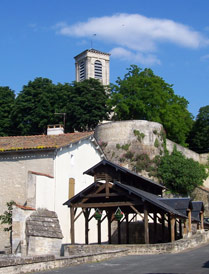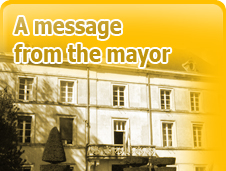A message from the mayor
![]()
|
Fabrice Michelet, |
Hello and welcome to the official site of the commune of CHEF-BOUTONNE.
We want this new means of communication, which the Communications Committee and the firm “Tête à Clic” have worked on for a long time, to be practical, informative and attractive.
|
History
 Chef Boutonne, originally called Caput Wulton, is named after the river Boutonne which rises there. The current population of the town, the main town of the canton of the same name, is 2,200. It is a commune with a long history. Several historic remains such as Gallo-Roman dwellings at Javarzay and Le Pouzac and a Merovingian burial site, where a terracotta jewel box, coins and pottery were found, bear witness to this.
Chef Boutonne, originally called Caput Wulton, is named after the river Boutonne which rises there. The current population of the town, the main town of the canton of the same name, is 2,200. It is a commune with a long history. Several historic remains such as Gallo-Roman dwellings at Javarzay and Le Pouzac and a Merovingian burial site, where a terracotta jewel box, coins and pottery were found, bear witness to this.
From the Middle Ages several lordships, Gontaut-Biron, La Rochefoucauld and then Lamoignon, succeeded each other. The last marquis of Chef Boutonne was the Marquis Lamoignon de Malesherbes, known for having defended Louis XVI at his trial.
During the French Revolution, Javarzay and Lussais, which had been separate communes, became part of Chef Boutonne.
A native of Chef Boutonne, Jean-François Cail, born in 1804, brought fame to the town by becoming one of the most important industrialists of the 19th century. He was also a leader in many other fields.
The history of the town and its inhabitants has been closely linked to the evolution of agriculture. The reduction in agricultural activity has seen the local economy turn more to the services sector and tourism.
This rich history is illustrated by the important buildings, the houses and the streets of the town.

Location
In the very heart of the Poitou-Charentes region, in the south of the Département of the Deux-Sèvres, Chef Boutonne is 40 kilometres from Niort, 60 from Angoulême, 80 from Poitiers and 100 from La Rochelle.
![]() Access
Access![]() Niort station, 40 minutes
Niort station, 40 minutes![]() Ruffec station, 25 minutes
Ruffec station, 25 minutes![]() Poitiers airport, 40 minutes
Poitiers airport, 40 minutes![]() La Rochelle airport, 1 hour 15 minutes
La Rochelle airport, 1 hour 15 minutes
Sites
 Château de Javarzay
Château de Javarzay
An ancient monument, the château of Javarzay, built in 1514 by François de Rochechouart on the site of an earlier castle, had 12 towers, a drawbridge and a round tower complete with machicolations.
To-day only two towers remain. The château with its orangerie, conical slate covered roofs and chapel is an example of Renaissance architecture in the Deux-Sèvres.
It houses the Headdress museum, and an exhibition about Jean-François Cail.
In addition there is an exhibition room for temporary exhibitions.
Since 1982 the château and its outbuildings, together with the grounds, have been the property of the commune.
In 1996 a lake was created in the grounds behind the château.
Tourists, anglers and walkers of all ages are frequent visitors to the site.
T he Church at Javarzay
he Church at Javarzay
This Romanesque church, dedicated to Saint Chartier and classified as an ancient monument in 1840, was built towards the middle of the 12th century. It contains some 100 sculptures and a tombstone carved in 1211. On one of the minor roads to Santiago de Compostella it was enlarged during the 16th century in order to accommodate the numerous pilgrims. In consequence the choir and portal add a Renaissance aspect to the building.
 The Church of Notre Dame
The Church of Notre Dame
 Chef Boutonne Castle
Chef Boutonne Castle
The castle was built on the rocky spur overlooking the source of the Boutonne. All that remains of this castle are the bases of two towers and a section of the outer walls. The place Malesherbes takes its name from the last marquis of Chef Boutonne, Louis XVI’s legal adviser at the time of the Revolution. There is a fine view over the town from the ramparts behind the church.
The Town Hall and Park

The offices of the commune occupy a building bought by Jean-François Cail. His bust is to be seen on the facade. The Town Hall is in a wooded park. One of the trees is a 500 year old cedar.

It is possible to visit an exhibition produced by the Association C.A.I.L. (Comité Autour d’un Inventeur Local) at the château of Javarzay. The main square in the centre of town and the Lycée Professionel both bear his name.The house in which he was born is to be seen in the “venelle” leading from the corner of the rue René Coynault.
The Boutonne
The river itself

The river has its source in Chef Boutonne, at the wash place on the rue de la Fontaine, then flows through part of the departments of the Deux -Sèvres and the Charente Maritime for 99 kilometres before joining the Charente at Carillon near Tonnay-Charente. The Bédoire, the Nie, the Sandrenne and the Trezence are its main tributaries.
During the 18th Century, in order to promote trade and facilitate the transport of pineau, it was made navigable over a distance of 33 kilometres downstream from St. Jean d’Angely.
In Chef Boutonne a number of other springs and resurgent streams feed the river. These include Coupeaume, Pytareau, the Fontaine de la Faiencerie, the Rossignol, Pouvareau, Chandant, the Pouzac, Pyroli, the Fontaine du Château, the Fontaine à Marion and the Fontaine du Pont-Neuf.
The water mills
The wash places

There were several of these “lavoirs” in Chef Boutonne including the one at the source of the Boutonne, the one at Javarzay next to the Maison des Lavandières and the ones at the Moulin Neuf and at Pouvareau.


 La Ville
La Ville





